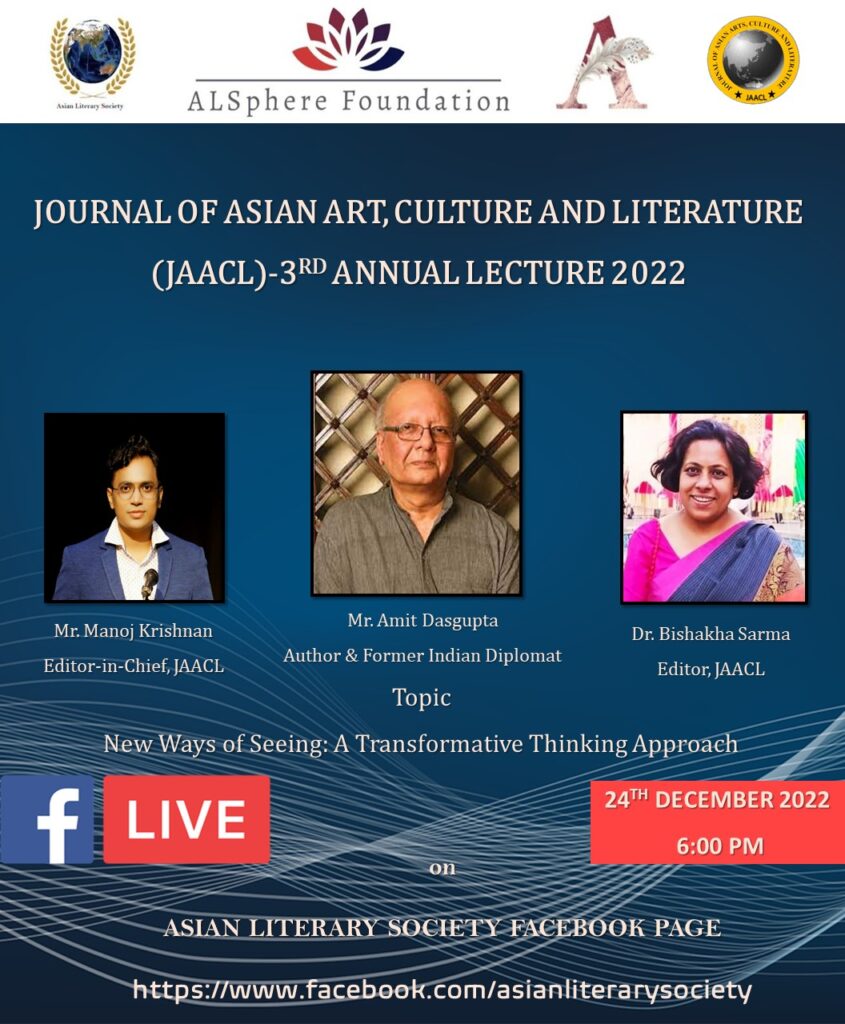The Journal of Asian Art, Culture and Literature (JAACL) in association with the Asian Literary Society holds the third Annual Lecture on “New Ways of Seeing: A Transformative Thinking Approach” by the eminent author and the former Indian Diplomat Mr. Amit Dasgupta on 24th December, 2022
The session was chaired by the Editor-in-Chief, JAACL and the Founder of the Asian Literary Society Mr. Manoj Krishnan and moderated by the Editor, JAACL, and the administrator of Asian Literary Society, Dr. Bishakha Sarma.
We make our own perceptions on various domains of our interest. Our mind is programmed with perceptions already formed. As a consequence, we often fall into the trap of prejudice because we learn to see in a particular way. According to the Austrian-American Sociologist, Peter L. Berger, “Life are social landscape”. Mr. Dasgupta points out that as much as we get influenced by the physical landscape, it impacts the way one thinks and the way one sees. Thus, the people from the Northeast are different from the people residing in North India. So also, he says social landscapes impact our mind. In the case of socialization, we have a predictable manner of judging people. He explains that the socialization process teaches norms and behavior that is recognizable or is acceptable to society. Any action which is not recognizable may be regarded as ‘Deviate behavior’. Thus we are taught in a manner so that we do not challenge the social system. The author goes further to say that even good people do bad things. This is the case when we show less tolerance toward the old aged ones or children. Our thinking thus, he says is primarily affected by two things:
1) Accumulation of personal experiences
2) Society teaches us norms
The author also mentions about the ‘Logotherapy developed by the neurologist and psychiatrist Viktor E.Frankl whom he calls it as ‘the Third Viennese School of Psychotherapy’. This is based on the understanding that the main motivation of a person lies in to seek for a meaning or purpose in life. The author states an example of the terrible situation of the Jews from Germany when they were deported to the ghettos and concentration camps. They lived every day with the hope to find their loved ones alive. It is found that men die of a broken heart. The author directs our attention to “how do we see the world?” At the same time, he guides us saying that “it is possible to embark on a different kind of life”. He provides examples from ‘Immersion in Christ’ or Sri Ramakrishna Paramhansa’s incredible cosmic joy in seeing Goddess Kali as he saw the power of divine Mother and everything around him.
Mr. Dasgupta, while working on the new transformative thinking sums up saying that the quest for fulfillment is reflected through the integrated matrix of passion, dispassion, and compassion:
- Passion is when you love what you do and do what you love.
- Dispassion is reflected in the ability to do without expectation. This also means to be equanimous
- Compassion is recognizing that our actions impact other people.
Thus, we commence towards a fulfilling life when we combine these 3 elements with our purpose in life. And this, the author considers to be the basis of happiness.
The objective, then, is to widen the lens and open the mind (the seeing) to go beyond the obvious and thereby, embrace what is rather than what appears to be. In Eastern philosophical thought this profound experience is referred to as Zen.
Finally, the author suggests that a “small revolution might change the existing paradigm”.


0 Comments